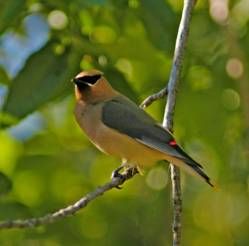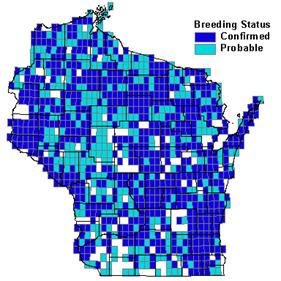

Status/Protection
- Global Rank: G5 Key to global and state ranks
- State Rank: S5B, SZN
- WBCI Priority: None
Population Information
The Federal BBS information can be obtained at http://www.mbr-pwrc.usgs.gov/bbs/bbs.html by clicking on Trend Estimates and selecting the species in question. All estimates are for time period (1966-2005).
- Federal Breeding Bird Survey: significant increase
- Federal Breeding Bird Survey (WI): stable
- Federal Breeding Bird Survey (BCR 23): significant increase
- Federal Breeding Bird Survey (BCR 12): stable
- WSO Checklist Project: significant increase (1983-2007)
Life History
- Breeding Habitat: Wide variety of habitats
- Nest: In thick shrubbery and trees, most commonly at 1.3 - 5 m
- Nesting Dates: Late June thru July
- Foraging: Fruit-eating, gleaning
- Migrant Status: Irregular resident; short-distance migrant
- Habitat use during Migration: Similar to breeding habitat
- Arrival Dates: Mid-May to mid-June north, irregular winter resident in Wisconsin
- Departure Dates: Early September to mid-October in northern Wisconsin
- Winter Range: Continental U.S. to Central America
- Winter Habitat: Open forests, forest regrowth, shrubs
Habitat Selection
The Cedar Waxwing is a familiar bird of forest edges, old fields, forest clearings, and residential areas (Witmer et al. 1997). Preferred habitat for both migration and nesting contains fruits and berries, which form the bulk of its diet. Starting in May, and throughout the summer, the Cedar Waxwing supplements its frugivorous diet with a considerable amount of insect prey (Witmer et a. 1997).
In contrast to most other songbirds, Cedar Waxwings do not maintain well-defined breeding territories, often foraging in small flocks for food (Bent 1950). Nests are located in a variety of deciduous and evergreen trees (Witmer et al. 1997), but most commonly are in hawthorns (Murphy et al. 1997) and cedars (Robbins 1991). Nests are not located in interiors of mature or closed-canopy forests (Witmer et al. 1997), and are more likely to fail in dense vegetation (Murphy et al. 1997). They usually are placed 1 to 15 m above the ground in a fork of a horizontal branch (Witmer et al. 1997).
During migration and winter, the Cedar Waxwing forages in open forests similar to those in which it breeds. Flocks during spring migration are found in fruit-bearing trees, as well as elms, oaks, and maples (Robbins 1991). Widely wandering flocks remain until breeding begins in mid-June, when the supply of fruits is reliable (Witmer et al. 1997).
Habitat Availability
The Cedar Waxwing in Wisconsin benefits from widespread and abundant breeding habitat in Wisconsin. Forest regeneration and shrubs planted in residential areas and parks have provided habitat in Wisconsin, as well as elsewhere in its range (Witmer et al. 1997). This species is a common breeder throughout the state.
Population Concerns
Cedar Waxwing populations have increased throughout the range of the species (Sauer et al. 2003), but most dramatically in the East (Witmer et al. 1997; Sauer et al. 2003).
A large number of waxwings die from striking windows and vehicles. Vegetation with berries or fruit placed next to large windows, whether indoor or outdoor, can result in collisions. Fruit-bearing shrubs planted in road medians likewise increase the frequency of collisions with vehicles (Witmer et al. 1997).
For several reasons, the Cedar Waxwing is a relatively poor host for the Brown-headed Cowbird, with a maximum of 16.7 % parasitism reported among studies. Waxwings begin nesting after most cowbirds have finished laying eggs, reducing parasitism pressure. Cowbird eggs commonly are ejected from the nest by the hosts, and parasitized nests commonly are abandoned if ejection fails. Also, Brown-headed Cowbird young grow poorly on the fruit-based diet provided by the waxwings, resulting in a low rate of fledging (Witmer et al. 1997).
Recommended Management
No management of the Cedar Waxwing is needed, as populations are widespread and growing. Breeding takes place after Breeding Bird Survey data are collected, limiting the usefulness of those data to determine status of breeding populations (Mossman and Lange 1982; Robbins 1991; Witmer et al. 1997). Efforts to educate the public on techniques to reduce window strikes and vehicular collisions would benefit this species as well as others.
Research Needs
No significant area of research on the Cedar Waxwing in Wisconsin is needed. For the species in general, Witmer et al. (1997) listed research priorities, including studying its movements and migration, social behavior, physiological adaptations to its diet, and its role in seed dispersal.
Information Sources
- Cornell Lab of Ornithology: http://birds.cornell.edu/BOW/CEDWAX/
- Patuxent Bird Identification Center : http://www.mbr-pwrc.usgs.gov/id/framlst/i6190id.html
- Wisconsin Breeding Bird Atlas: http://www.uwgb.edu/birds/wbba/
References
- Anon. 2002a. Forest Birds of Minnesota. University of Minnesota - Duluth. http://oden.nrri.umn.edu/mnbirds/Default.htm.
- Anon. 2002b. NatureServe Explorer.www.natureserve.org/explorer/
- Anon. 2002c. Wisconsin Breeding Bird Atlas: http://www.uwgb.edu/birds/wbba/
- Anon. 2002d. Wisconsin Natural Heritage Inventory Working List. http://www.dnr.state.wi.us/org/land/er/working_list/taxalists/birds.htm
- Bent, A. C. 1950. Life histories of North American wagtails, shrikes, vireos, and their allies. U.S. Natl. Mus. Bull. 197. 411 pp.
- Hilsenhoff, W. L. 2000. Sixty years of Wisconsin Christmas bird counts. Passenger Pigeon 62(1):7-19.
- Mossman, M. J., and K. I. Lange. 1982. Breeding birds of the Baraboo Hills, Wisconsin: Their history, distribution and ecology. Wis. Dep. Nat. Resour. and Wis. Soc. Ornithol., Madison.
- Murphy, M. T., C. L. Cummings, and M. S. Palmer. 1997. Comparative analysis of habitat selection, nest site and nest success by Cedar Waxwings (Bombycilla cedorum) and eastern kingbirds (Tyrannus tyrannus). Amer. Midl. Nat. 138: 344-356.
- Robbins, S. D., Jr. 1991. Wisconsin birdlife: Population and distribution past and present. Madison, WI: Univ. Wisconsin Press.
- Rothstein, S. I. 1976. Cowbird parasitism of the Cedar Waxwing and its evolutionary implications. Auk 93: 498-509.
- Sauer, J. R., J. E. Hines, and J. Fallon. 2003. The North American Breeding Bird Survey, Results and Analysis 1966 - 2002. Version 2003.1, USGS Patuxent Wildlife Research Center, Laurel, MD. http://www.mbr-pwrc.usgs.gov/bbs/bbs.html
- Temple , S. A., J. R. Cary, and R. Rolley. 1997. Wisconsin birds: a seasonal and geographical guide, 2 nd edit. University of Wisconsin Press, Madison.
- Witmer, M. C., D. J. Mountjoy, and L. Elliott. 1997. Cedar Waxwing. The Birds of North America, No. 309 (A. Poole and F. Gill, eds.). The Birds of North America, Inc., Philadelphia, PA.
- Young, H. 1963. Breeding success of the cowbird. Wilson Bull. 75: 122.
Contact Information
- Compiler: Tom Klubertanz, Dept. of Biological Sciences, University of Wisconsin - Rock County, 2909 Kellogg Ave., Janesville, WI 53546, 608-758-6553, 608-757-9203, tklubert@uwc.edu
- Editor: Gary Zimmer, 715-674-7505, rgszimm@newnorth.net
